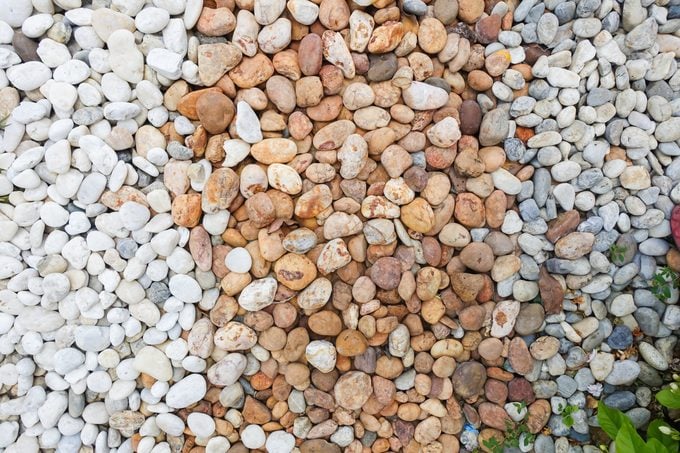Gravel and crushed rock aren't the same thing. Gravel consists of rocks and pebbles with rounded edges, and it's primarily a landscaping material.

Everything You Ever Wanted to Know About Landscaping Gravel

I just made a trip to the local rockery to buy fill for the potholes on our dirt driveway, which needs extensive repairs after the stormy California winter. I chose something called granite screenings, consisting of tiny pieces of rock. I asked the clerk if this would be considered gravel, and he said all they sell is gravel.
Not everyone would agree with that.
Of the twenty or so bins of material at the rockery, only a few contained what most landscapers call gravel. Most had crushed rock, which is a different thing.
Builders use crushed rock for construction and road projects because it’s sharp, angular and holds together. Mined in quarries and processed by heavy machinery, it’s only been in widespread use since World War II.
Gravel has been around forever and occurs naturally, which may be one reason why people like the rockery clerk often use the term generically. But it’s important to understand how it differs from crushed rock. If you use one when you should have used the other, your construction project may fail, or your landscaping project won’t turn out the way you want.
On This Page
What Is Gravel?
The word “gravel” comes from the French “gravelle,” which means coarse sand. It refers to materials obtained from natural sources — rock formations, rivers, lakes and seashores.
Gravel weathered by the elements features smooth edges and won’t lock together the way crushed rock will. That’s why it’s used mostly for aesthetic purposes, particularly in landscaping.
Producers make artificial gravel from certain types of crushed rock by tumbling them to round the edges and simulate natural weathering. This makes the rocks suitable for patios, walkways and other garden projects. Unlike some types of crushed rock, gravel never combines rocks and rock dust. It consists only of pebbles and/or rocks.
Gravel varies in color, depending on where it comes from and the type of rock in the mix. Colors range from predominantly gray to earth tones (e.g. beige and brown) to white. Producers use screens to separate batches into pebbles with the following sizes:
- Very fine: 0.08- to 0.16-in.;
- Fine: 0.17- to 0.32-in.
- Medium: 0.33- to 0.63-in.
- Coarse: 0.64- to 1.25-in.;
- Very coarse: 1.26- to 2.52-in.;
- Cobbles: 2.53- to 8-in.;
- Boulders: Larger than 8-in.
Types of Gravel

Eliminating road rock, drainage rock, base rock and other types of crushed stone narrows the selection of gravel types significantly. True gravel comes directly from the ground or waterways. It may be screened for size, washed, colorized or tumbled, but it’s never fed through a rock crusher.
Here are the most common types:
- Pea gravel: This consists of rounded pebbles 1/8- to 3/8-in. in diameter. Individual pebbles are about the size of peas, hence the name. This is probably what the French referred to with the name “coarse sand.” Each pebble has its own color, but together the overall hue is usually beige to light brown. A particular type known as Jersey Shore gravel is known for its striking tan and gold colors.
- River rock: Individual stones with diameters from one to several inches. The stones come from river beds, smoothed by years of exposure to flowing water. Most are gray, but some are lighter, almost white. Others are on the darker side.
- Lava rock: Basically, chunks of solidified lava tumbled to blunt its sharp edges. It’s lightweight, porous and usually deep rusty.
- Marble chips: They’re white, making them popular for attractive xeriscape features. The individual pieces may have been smoothed by natural weathering. If not, they’re usually tumbled.
- Crushed granite: Another natural stone that can be turned into gravel by tumbling. Its rich, dark color adds depth to a landscape design.
Best Uses for Gravel
Landscapers use pea gravel, marble chips and crushed granite for gravel patios, walkways and xeriscaping. They’re easier on the feet than crushed stone with sharp edges but won’t lock together on their own, requiring a border to stay in place. That’s often OK, because the border separates the landscape into well-defined spaces.
River rocks can serve multiple purposes outdoors. Use them for decorating, creating drainage pathways and building cobblestone patios and walkways.
Because of its porosity, lava rock makes a good substitute for mulch in the garden. Its deep red color makes it a string decorative feature. You can also use it to make patios and walkways.
Gravel Maintenance Best Practices
Landscape gravel doesn’t need as much maintenance as a lawn or other types of vegetation, but it does need some.
The biggest potential issue is weed growth. Even with an underlayment of landscape fabric to block weeds, you still must be on the lookout. Check for new growth every week. Pull weeds as soon as you see them to prevent them from spreading.
When you use pea gravel, marble chips, lava rock or crushed granite, you need a border to keep them contained. But stones and pebbles always seem to magically find their way outside the borders to the sidewalk or the garden. It’s difficult to prevent this but easy to sweep up errant stones, especially if you do it regularly.
Some types of gravel, particularly crushed granite, need to be replenished periodically as they wear down. Use a leaf blower on low power to move leaves, sticks and other lightweight debris. And that’s pretty much all there is to it.




















